Page 245 of 433
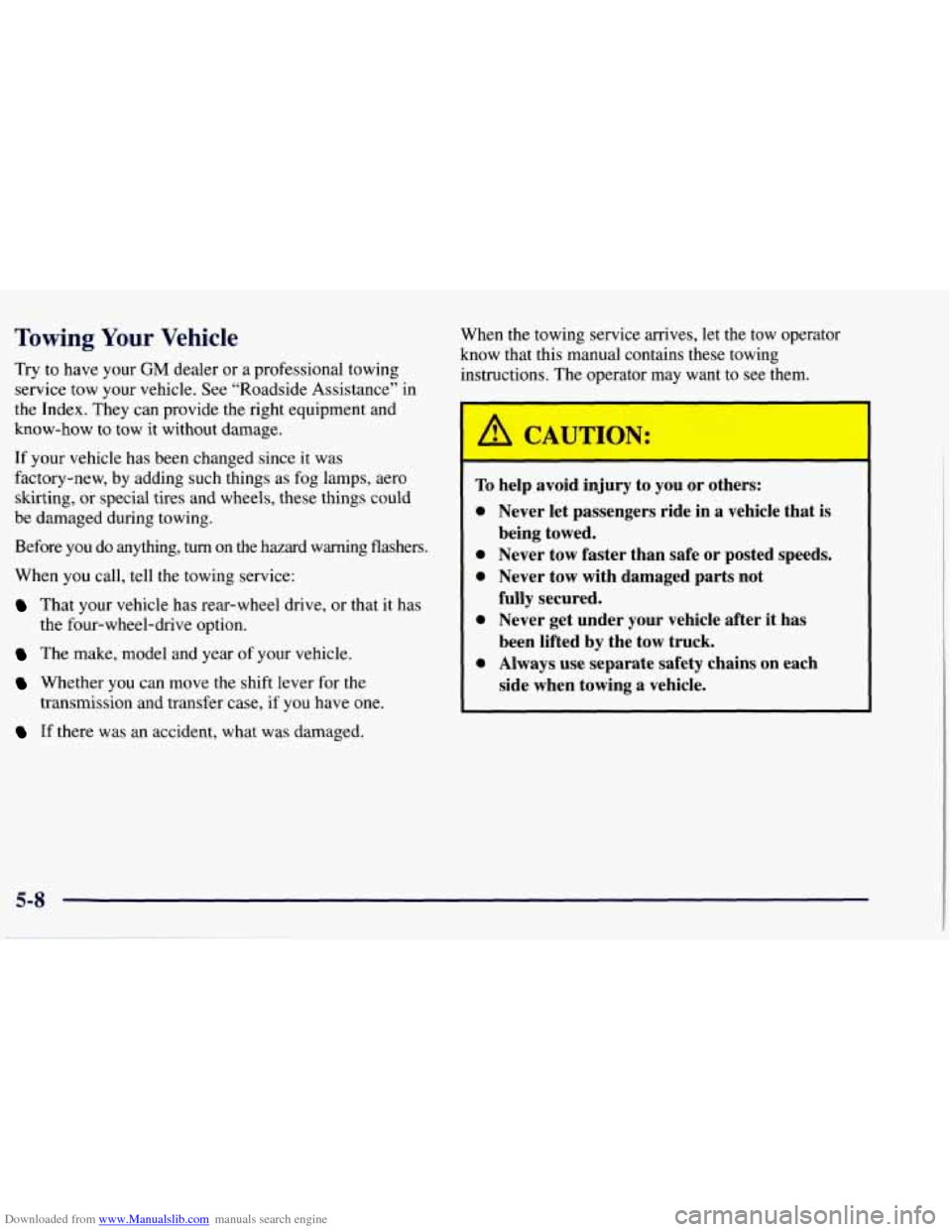
Downloaded from www.Manualslib.com manuals search engine Towing Your Vehicle
Try to have your GM dealer or a professional towing
service tow your vehicle. See “Roadside Assistance” in
the Index. They can provide the right equipment and
know-how to tow it without damage.
If
your vehicle has been changed since it was
factory-new, by adding such things as
fog lamps, aero
skirting,
or special tires and wheels, these things could
be damaged during towing.
Before you
do anythmg, turn on the hazard warning flashers.
When you call, tell the towing service:
That your vehicle has rear-wheel drive, or that it has
The make, model and year of your vehicle.
Whether you can move the shift lever for the
If there was an accident, what was damaged.
the
four-wheel-drive option.
transmission and transfer case,
if you have one. When
the towing service arrives, let the tow operator
know that this manual contains these towing
instructions. The operator may want to see them.
To help avoid injury to you or others:
0 Never let passengers ride in a vehicle that is
0 Never tow faster than safe or posted speeds.
being
towed.
~ 0 Never tow with damaged parts not
’ 0 Never get under your vehicle after it has
~ been lifted by the tow truck.
fully
secured.
0 Always use separate safety chains on each
side when towing a vehicle.
Page 246 of 433
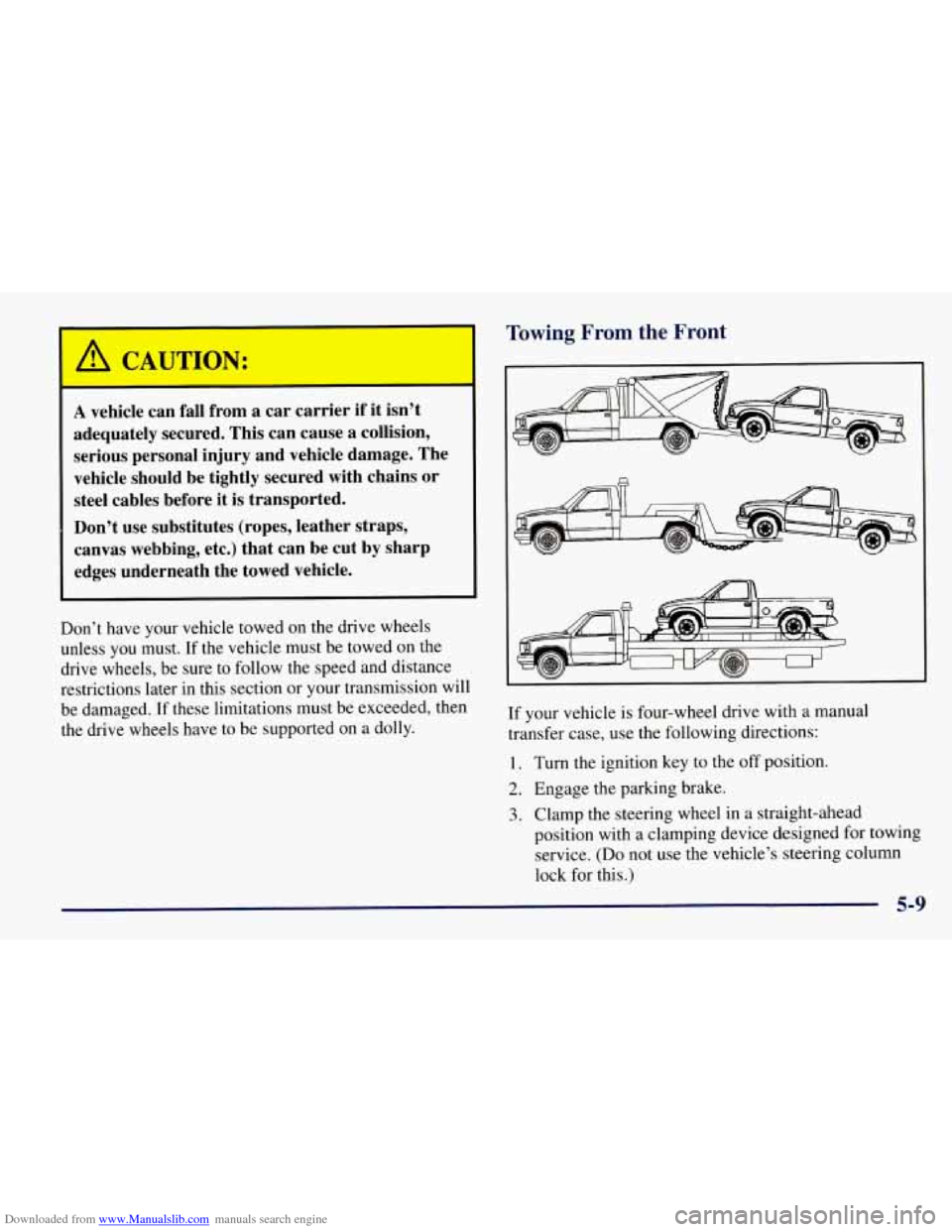
Downloaded from www.Manualslib.com manuals search engine Towing From the Front
A vehicle can fall from a car carrier if it isn’t
adequately secured. This can cause a collision,
serious personal injury and vehicle damage. The
vehicle should be tightly secured with chains or
steel cables before it is transported.
Don’t use substitutes (ropes, leather straps,
canvas webbing, etc.) that can be cut by sharp
edges underneath the towed vehicle.
Don’t have your vehicle towed on the drive wheels
unless you must. If the vehicle must be towed
on the
drive wheels, be sure to follow the speed and distance
restrictions later in this section or your transmission will
be damaged.
If these limitations must be exceeded, then
the drive wheels have to be supported on a dolly. If
your vehicle is four-wheel drive with a manual
transfer case, use the following directions:
1. Turn the ignition key to the off position.
2. Engage the parking brake.
3. Clamp the steering wheel in a straight-ahead
position with a clamping device designed for towing
service. (Do not use the vehicle’s steering column
lock for this.)
5-9
Page 247 of 433

Downloaded from www.Manualslib.com manuals search engine 4. Put the transmission in PARK (P).
5. Put the transfer case in NEUTRAL (N).
6. When the vehicle is hooked up, release the
7. Maximum speed 55 mph (88 km/h),
If your vehicle is a two-wheel drive or a four-wheel
drive with an electric shift transfer case, use the
following directions:
1. Turn the ignition key to the OFF position.
2. Engage the parking brake.
3. Clamp the steering wheel in a straight-ahead
parking
brake.
distance unlimited.
position with a clamping device designed for towing
service.
(Do not use the vehicle’s steering column
lock for this.)
4. Put the transmission in NEUTRAL (N).
5. Put the transfer case in 2HIGH (2HI).
6. When the vehicle is hooked up, release the
7. Maximum speed 35 mph (55 km/h), maximum
parking
brake.
distance
50 miles (80 km).
Towing From the Rear
I 3
NOTICE:
If your vehicle is equipped with a manual or
electric shift transfer case, a towing dolly must be
used under the front wheels or vehicldpowertrain
damage will occur.
SI1 n
Page 249 of 433
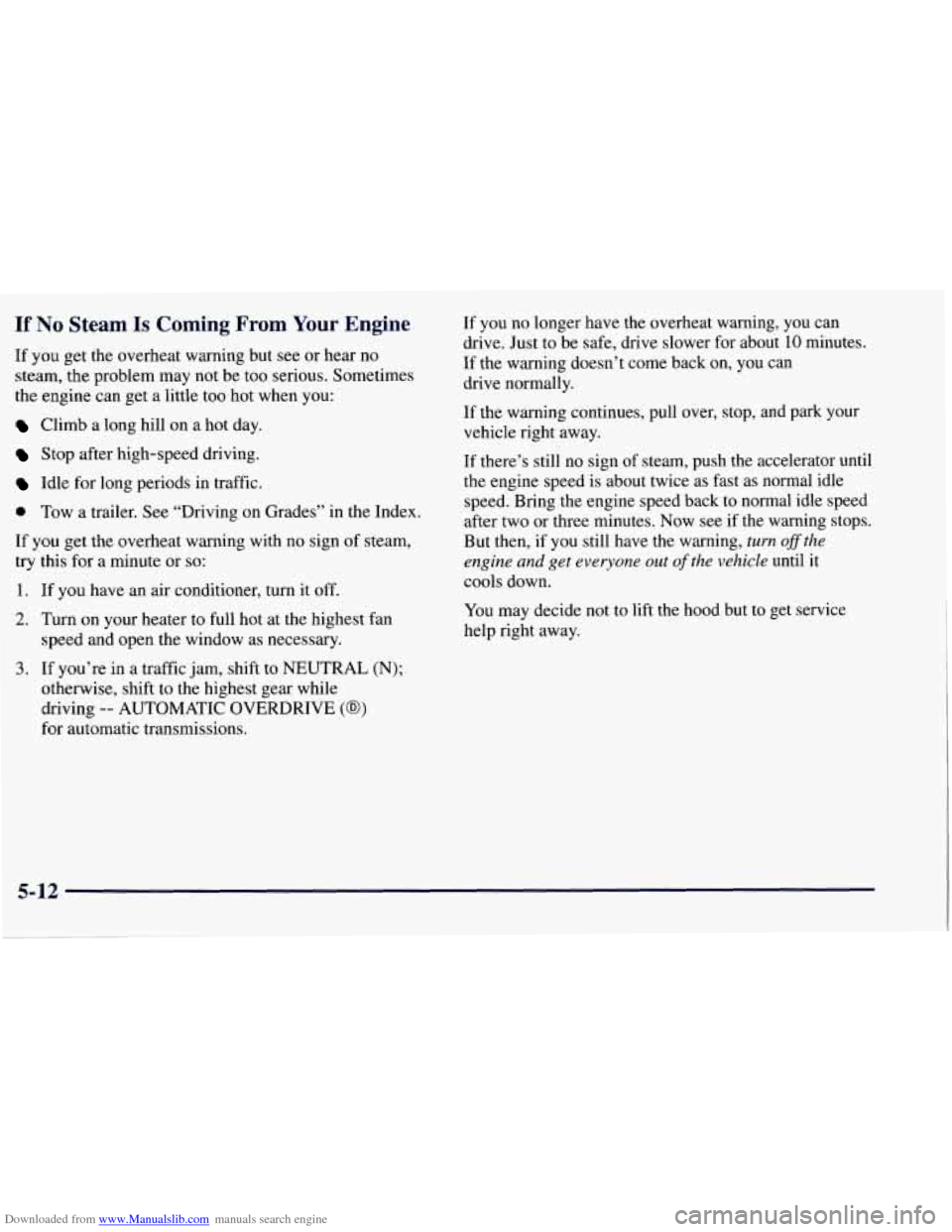
Downloaded from www.Manualslib.com manuals search engine If No Steam Is Coming From Your Engine
If you get the overheat warning but see or hear no
steam, the problem may not be too serious. Sometimes
the engine can get a little too hot when you:
Climb a long hill on a hot day.
Stop after high-speed driving.
Idle for long periods in traffic.
0 Tow a trailer. See “Driving on Grades” in the Index.
If you get the overheat warning with no sign of steam,
try this for a minute or
so:
1. If you have an air conditioner, turn it off.
2. Turn on your heater to full hot at the highest fan
speed and open the window as necessary.
3. If you’re in a traffic jam, shift to NEUTRAL (N);
otherwise, shift to the highest gear while
driving
-- AUTOMATIC OVERDRIVE (a)
for automatic transmissions. If you
no longer have
the overheat warning, you can
drive. Just to be safe, drive slower for about
10 minutes.
If the warning doesn’t come back on, you can
drive normally.
If the warning continues, pull over, stop, and park your
vehicle right away.
If there’s still no sign
of steam, push the accelerator until
the engine speed is about twice as fast as normal idle
speed. Bring the engine speed back to normal idle speed
after two or three minutes. Now see if the warning stops,
But then, if you still have the warning,
turn oflthe
engine
and get everyone out of the vehicle until it
cools down.
YOU may decide not
to lift the hood but to get service
help right away.
5-12
Page 251 of 433
Downloaded from www.Manualslib.com manuals search engine A CAUTION:
Heater and radiator hoses, and other engine
parts, can be very hot. Don’t touch them.
If you
do, you can be burned.
Don’t run the engine if there is
a leak. If you run
the engine, it could lose all coolant. That could
cause an engine fire, and you could be burned.
Get any leak fixed before you drive the vehicle.
The coolant level should be at or above the COLD mark. I NOTICE:
If it isn’t, you may have a leak in the radiator hoses,
heater hoses, radiator, water pump or somewhere else in
the cooling system.
Engine damage from running your engine
without coolant isn’t covered by your warranty.
If there seems to be no leak, start the engine again. See
if the fan speed increases when idle speed is doubled by
pushing the accelerator pedal down.
If it doesn’t, your
vehicle needs service. Turn off the engine.
5-14
Page 280 of 433
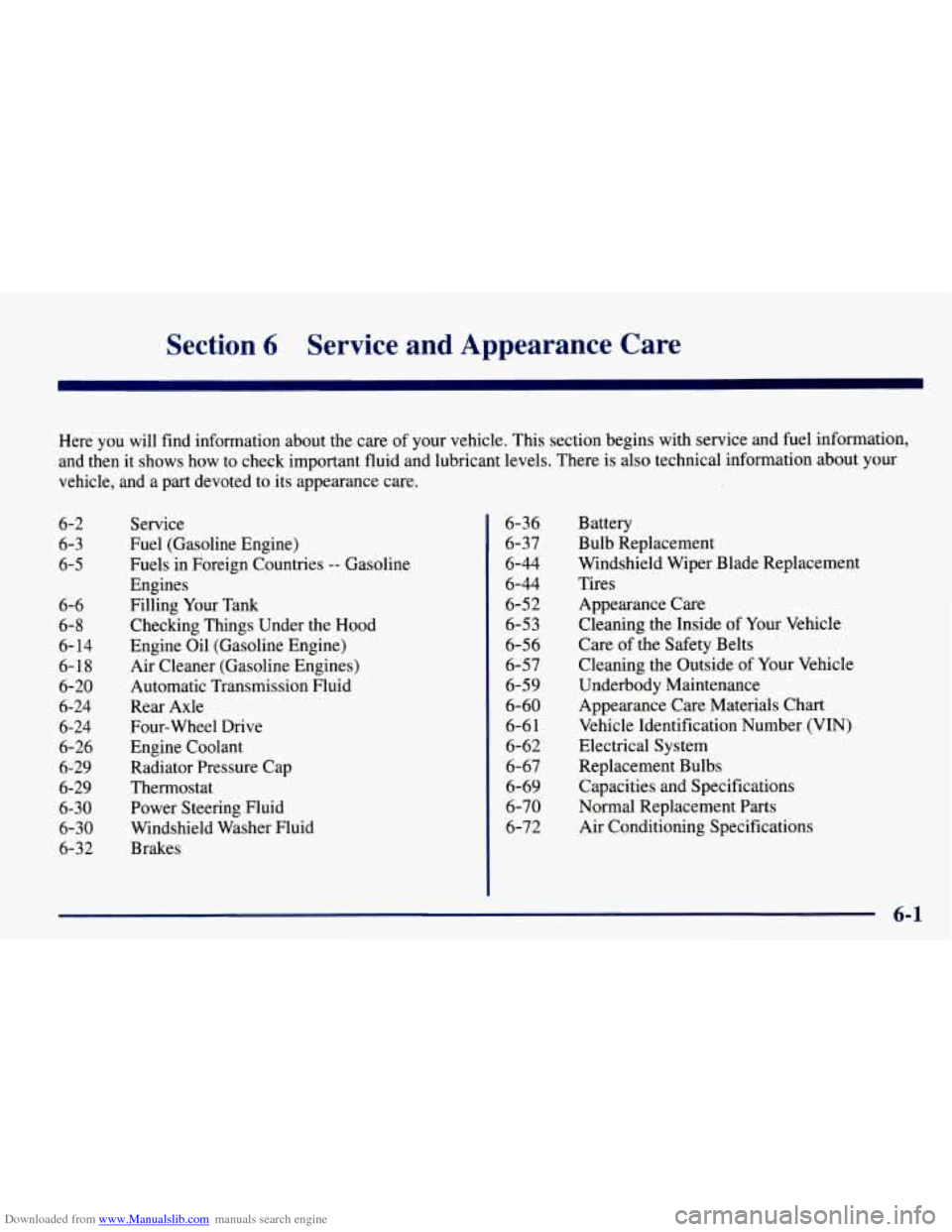
Downloaded from www.Manualslib.com manuals search engine Section 6 Service and Appearance Care
Here you will find information about the care of your vehicle. This section begins with service and fuel information,
and then it shows how to check important fluid and lubricant levels. There is also technical information about your
vehicle, and a part devoted to its appearance care.
6-2
6-3
6-5
6-6
6-8
6- 14
6-18
6-20
6-24 6-24
6-26
6-29
6-29
6-30
6-30
6-32 Service
Fuel (Gasoline Engine)
Fuels
in Foreign Countries -- Gasoline
Engines
Filling Your Tank
Checking Things Under the Hood
Engine Oil (Gasoline Engine)
Air Cleaner (Gasoline Engines)
Automatic Transmission Fluid
Rear Axle
Four-wheel Drive
Engine Coolant
Radiator Pressure Cap
Thermostat
Power Steering Fluid
Windshield Washer Fluid
Brakes
6-36
6-37
6-44
6-44
6-52
6-53
6-56
6-57
6-59
6-60 6-6 1
6-62
6-67
6-69
6-70
6-72 Battery
Bulb Replacement
Windshield Wiper Blade Replacement
Tires Appearance Care
Cleaning the Inside
of Your Vehicle
Care of the Safety Belts
Cleaning the Outside of Your Vehicle
Underbody Maintenance
Appearance Care Materials Chart
Vehicle Identification Number (VIN)
Electrical System
Replacement Bulbs
Capacities and Specifications
Normal Replacement Parts
Air Conditioning Specifications
6-1
Page 281 of 433
Downloaded from www.Manualslib.com manuals search engine Service
Your GM dealer knows your vehicle best and wants you
to be happy with it. We hope you’ll go to your dealer for
all your service needs. You’ll get genuine GM
parts and
GM-trained and supported service people.
We hope you’ll want to keep your GM vehicle all GM.
Genuine GM parts have one
of these marks:
n
Delco
Doing Your Own Service Work
If you want to do some of your own service work, you’ll
want to get the proper service manual. It tells you much
more about how to service your vehicle than this manual
can.
To order the proper service manual, see “Service
and Owner Publications” in the Index.
Your vehicle has an air bag system. Before attempting
to do your own service work, see “Servicing Your
Air Bag-Equipped Vehicle” in the Index.
You should keep a record with all parts receipts and list
the mileage and
the date of any service work you
perform. See “Maintenance Record”
in the Index.
6-2
Page 282 of 433
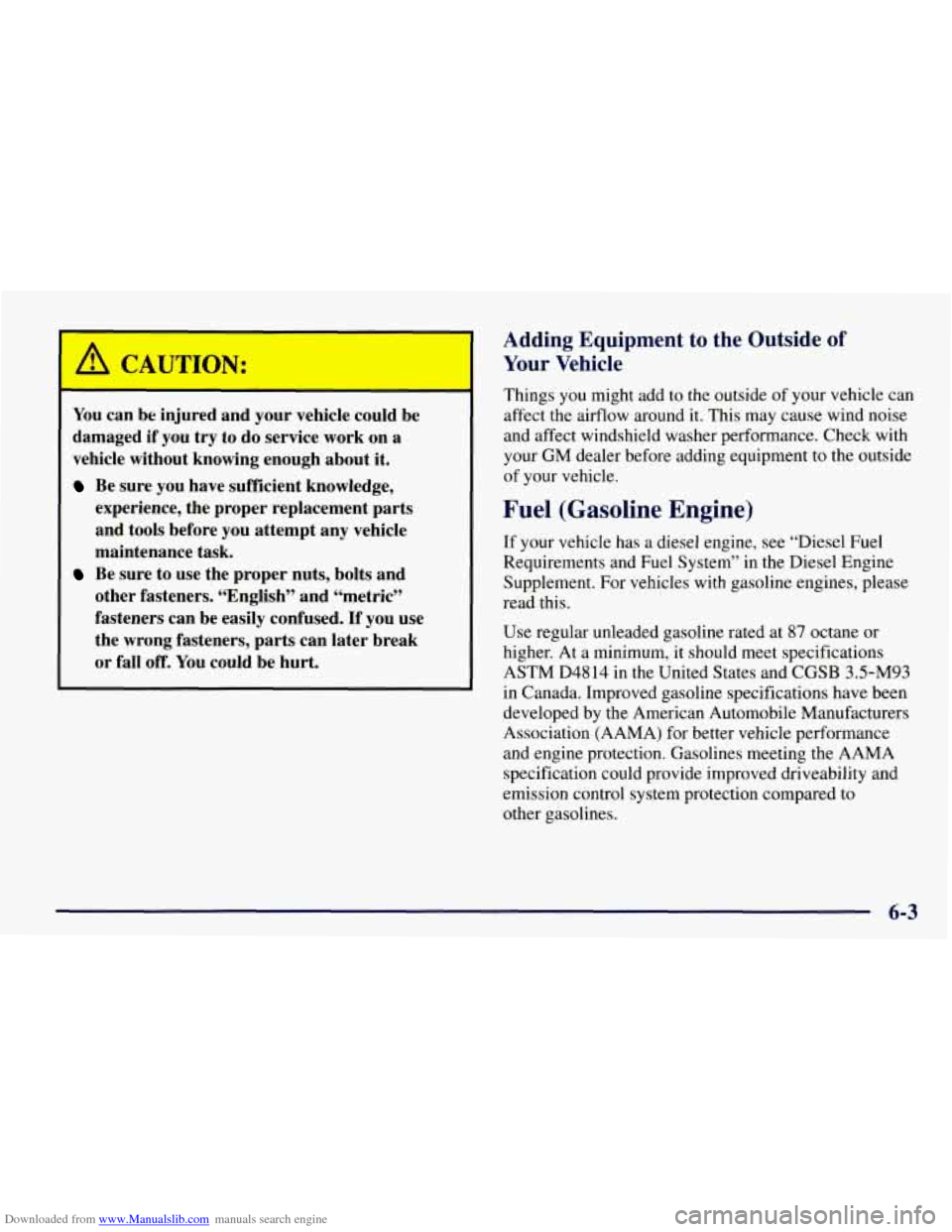
Downloaded from www.Manualslib.com manuals search engine A CAUTION:
You can be injured and your vehicle could be
damaged if you
try to do service work on a
vehicle without knowing enough about it.
Be sure you have sufficient knowledge,
experience, the proper replacement parts
and tools before you attempt any vehicle
maintenance task.
Be sure to use the proper nuts, bolts and
other fasteners. “English” and “metric”
fasteners can be easily confused. If you use
the wrong fasteners, parts can later break
or fall
off. You could be hurt.
Adding Equipment to the Outside of
Your Vehicle
Things you might add to the outside of your vehicle can
affect the airflow around it. This may cause wind noise
and affect windshield washer performance. Check with
your
GM dealer before adding equipment to the outside
of your vehicle.
Fuel (Gasoline Engine)
If your vehicle has a diesel engine, see “Diesel Fuel
Requirements and Fuel System” in the Diesel Engine
Supplement. For vehicles with gasoline engines, please
read this.
Use regular unleaded gasoline rated at
87 octane or
higher. At a minimum, it should meet specifications
ASTM D4814 in the United States and CGSB 3.5-M93
in Canada. Improved gasoline specifications have been
developed by the American Automobile Manufacturers
Association (AAMA) for better vehicle performance
and engine protection. Gasolines meeting the AAMA
specification could provide improved driveability
and
emission control system protection compared to
other gasolines.
6-3